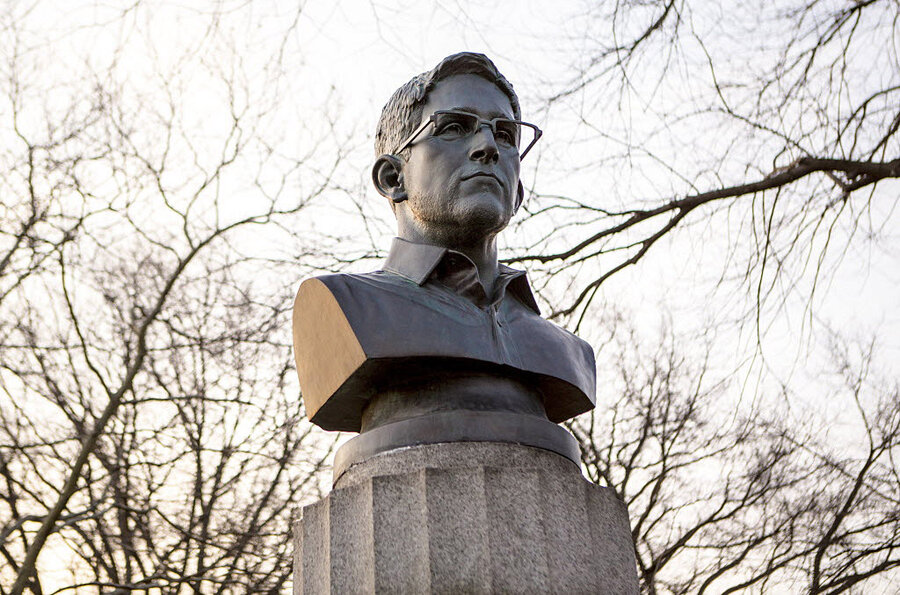Snowden statue points to divide in US society: Is he hero or traitor?
Loading...
A group of guerrilla artists' lofty, albeit controversial, goal of enshrining whistle-blower Edward Snowden among the ranks of American heroes was thwarted on Monday as New York City Department of Parks & Recreation officials promptly removed a bust of Mr. Snowden that the artists had installed atop a war memorial in Brooklyn, N.Y.
The group of artists, whose identities have not been confirmed, had fastened a custom-made bust of the former National Security Agency contractor to part of the Prison Ship Martyrs Monument, a memorial to Revolutionary War soldiers. The parks department quickly covered the unsanctioned bust with a tarp and removed it shortly thereafter.
But while the dance of discord played out by the activist artists and park officials may have amused local spectators, it is representative of a divide within American society: the split between those who view Snowden as a national hero and those who believe he is a traitor.
According to a January 2014 poll by the Pew Research Center, while public opinion is divided over whether the Snowden leaks served the public interest, most young Americans are supportive of Snowden.
“57% of 18- to 29-year olds said the leaks have served rather than harmed the public interest .... These youngest adults were the only age group without majority support for prosecuting Snowden – they split 42%-42% on whether the former NSA contractor should be tried,” Drew DeSilver wrote for Pew.
The Snowden case has been polarizing since the beginning. In 2013, Snowden’s leaks, originally reported by former Guardian journalist Glenn Greenwald and documentary filmmaker Laura Poitras, exposed an extensive, covert surveillance program that spied on US citizens, residents, and foreigners alike. But while some painted Snowden as a hero dedicated to transparency, others labeled him a national traitor.
"For society to function well, there have to be basic levels of trust and cooperation, a respect for institutions and deference to common procedures," David Brooks wrote in The New York Times in 2013. "By deciding to unilaterally leak secret N.S.A. documents, Snowden has betrayed all of these things."
The artists disagree.
“Fort Greene’s Prison Ship Martyrs Monument is a memorial to American POWs who lost their lives during the Revolutionary War. We have updated this monument to highlight those who sacrifice their safety in the fight against modern-day tyrannies. It would be a dishonor to those memorialized here to not laud those who protect the ideals they fought for, as Edward Snowden has by bringing the NSA’s 4th-Amendment-violating surveillance programs to light. All too often, figures who strive to uphold these ideals have been cast as criminals rather than in bronze,” they wrote in a statement published by the New York-based online news publication Animal.
Meanwhile, some argue that rather than just demonstrating support for Snowden, the bust would help raise awareness about the issue of surveillance, as most Americans don’t even know who Snowden is.
The statue appeared in the park the morning after HBO aired comedian John Oliver’s interview with Snowden, during which he presented a video of interviews with numerous people in Times Square who didn’t know who Snowden is. Mr. Oliver said the sample group interviewed was “representative.”
Then again, Snowden's leaks were not meant to be about himself; they were meant to shed light on an issue of national and international import, covert government surveillance.
The artists behind the Snowden bust said they realized that he would be unhappy with their decision to showcase his image because the leaks were “never meant to be about him.” However, they stressed that they hoped “he would understand,” Animal reported.
Demonstrating a streak of tenacity, other Snowden supporters decided not to let the bust’s removal prevent them from drawing attention to the issues and to the man. The evening after the statue was removed, another group of activists, known as the Illuminator Art Collective, sneaked into the park and projected a blue image of the sculpture onto the column where the bust was, Animal said.
Regarding the installation of the bust, parks department spokeswoman Maeri Ferguson told Mashable that the sculpture had been removed because "the erection of any unapproved structure or artwork in a city park is illegal.” The New York Police Department said it is investigating the “art prank.”






